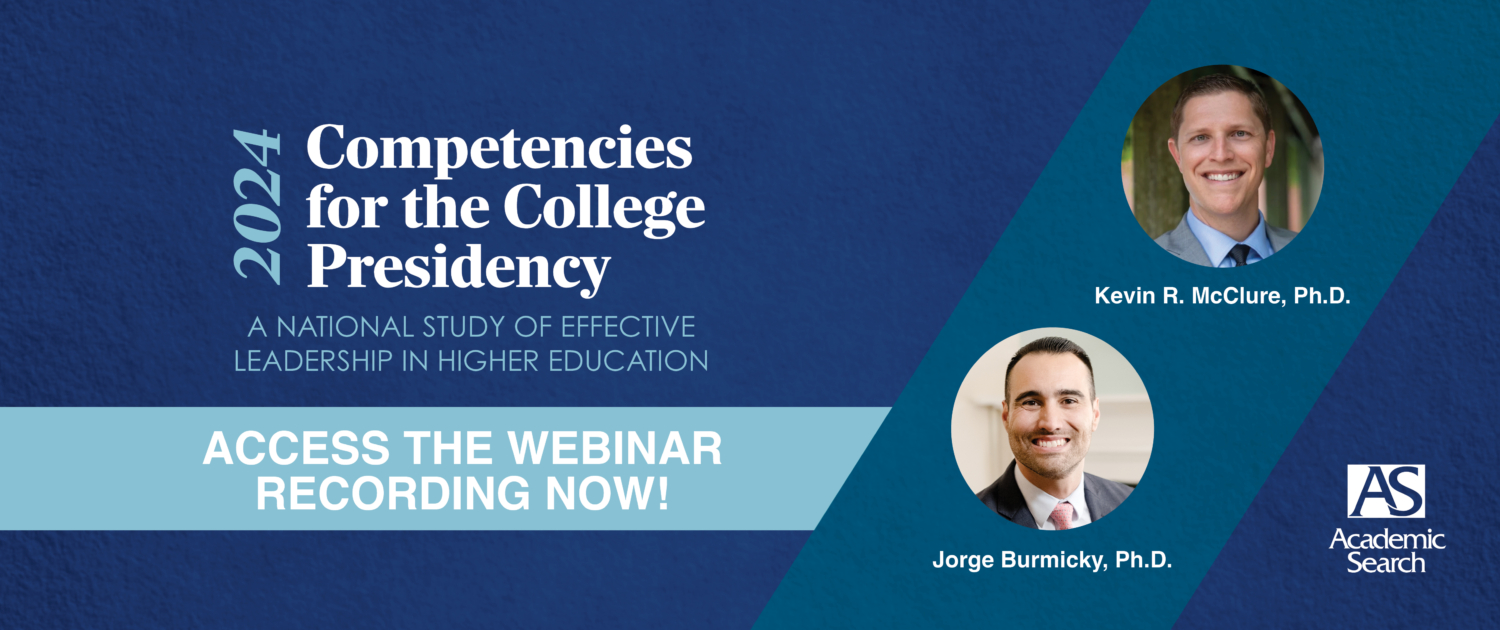
The Use of Technology in Higher Education Executive Search
By Shawn M. Hartman, Ed.D. | December 2021
Companies across all industries pivoted to more technological approaches to executive search and recruitment when the pandemic began in early 2020. Higher education search might have been less prepared than most.
Ours is a field that has not prioritized the use of technology. The unique nature of the shared governance model – decision-making that incorporates input from many stakeholders – creates a culture that values and expects personal connections, relationship building, and human capital. Thus, shared governance impacts the way that executive search is carried out for colleges and universities versus other sectors and industries.
Higher education executive search is not relying on artificial intelligence (AI) to scan resumes or cull pools of candidates; we continue to review each application in detail for every search with which we assist, and we then try to speak with as many candidates as we can before meeting with search committees to aid them in narrowing the candidate pool. All application materials are presented to the search committee; we do not use technology to select a handful of candidates for consideration by the committee.
In addition, whereas many other sectors have begun to incorporate the use of AI or technology for psychological or skills assessments at various stages of the search process, higher education has not adopted this practice. Both the candidates and the host institutions remain unsure what assessments to use, the validity of the assessments, and how to build them into the process.
This is not to say that technology has not made the overall application process simpler and, in many ways, more confidential. No longer do candidates have to mail in their materials, creating efficiencies in the process and fewer chances of individuals outside of the search learning of their identities. Technology has allowed materials to be shared via email directly with us as the consultants facilitating a search and for us to make materials available to committee members confidentially through a secure password-protected website. The use of application portals and other means is now commonplace across our industry as well as others. Higher education faces the challenges of open records or “sunshine” laws that private sector search does not face, and technology can help to navigate those challenges as well.
Technology has also streamlined the end stages of the search process with greater efficiencies in collecting feedback from those constituent groups who meet with finalist candidates as well as in the due diligence in the form of media and background checks that are performed on these select few. Still, although the pandemic has accelerated trust in technology and even the most “old school” practitioner can appreciate the benefits, there are those who will wish to do things the way they have always been done, with the use of paper copies for instance versus an electronic survey to ensure shared responses after a finalist’s visit to campus.
The most significant technological change in the search process, however, even prior to the onset of the pandemic, has been the increased use of virtual meetings, interviews and otherwise, at significant milestones in the process.
Whereas we would visit a campus for one or two full days at the start of a search, since the pandemic, all search committee meetings, including pre-search constituent conversations have been held via video. Not traveling for these meetings has surely been convenient but has not always been more efficient; we are frequently nostalgic for a time when we could participate in a number of meetings during a set one or two days rather than having the meetings drawn out over a couple of weeks or even a month.
Prior to the pandemic, video interviews were the exception rather than the rule. A lot of time and effort was spent on behalf of the institution organizing hotel logistics, and the institution incurred a significant financial cost as well. It would also take weeks to coordinate candidate travel in between the selection meeting and the in-person interviews. Video interviews have sped up the process by allowing initial interviews to be scheduled and held quickly.
Technology has also allowed us to cast a wider net by accommodating candidates from out-of-state or who cannot travel easily. With the ability to conduct interviews via Zoom, candidates can participate in the early stages of a search without impacting their family life or vacation time or alerting their colleagues to their desire to explore new opportunities. No longer do candidates nor search committees need to take extended time away from their campuses or spend hours coordinating travel logistics or filling out expense reports. Search committees also tend to be more open to interviewing additional candidates when doing so costs so little in both time and money.
The convenience of virtual interviews has also allowed for additional rounds of interviews to get to know candidates better. In hindsight, it is surprising how many hiring decisions were previously made based on a single “airport interview” and then a visit to campus. We have witnessed the profound difference that adding a second round of initial interviews has made to the search process in providing for a much more reliable data set when evaluating candidates. Some candidates didn’t show up as well; others were better the more you talked to them.
Virtual meetings have also changed the power dynamics in the interview room. On Zoom, we are all just the same square. Communicating through a screen offers less information about physical appearance that, in person, can contribute to bias. Interviews are one of the least reliable predictors of future performance, yet they are still the main tool by which search committees base their decisions. Holding initial interviews virtually can prevent strong candidates from being dismissed too soon based on the lack of strength in their handshake or how they didn’t look “executive” enough to committee members. However, bias can creep into virtual interviews in the form of accessibility; for instance, the quality of an interview can be impacted by a candidate’s rural setting and spotty internet connection.
Virtual meetings, while convenient and more affordable, do come with a cost of social capital.
Although at the height of the pandemic, many institutions had to come up with creative ways of getting to know finalist candidates without having them on campus, institutions are moving back to in-person final round interviews – nothing can quite replace the need for personal interaction for critical hiring decisions.
Technology may allow us easier access to a shallow understanding of a greater number of people, but there is no virtual substitute for the time spent with board members, search committee chairs, or candidates over meals, during drives, or between meetings, getting to know one another as humans.
About the Author

Shawn M. Hartman, Ed.D.
Senior Vice President and Chief Operating Officer
Dr. Shawn M. Hartman has primary responsibility for overseeing day-to-day operations at Academic Search. In his role, he’s supervised numerous nationwide searches, ensuring dedicated resources for each partnership. Dr. Hartman’s profound understanding of the academic search process, coupled with his administrative expertise, positions him as a valuable asset in navigating the intricacies of higher education recruitment. His journey began in student affairs at Westfield State University and spanned roles at Fisher College, political engagements, and growing a prominent law firm. Dr. Hartman holds a Doctor of Education from Northeastern University, an MBA from Colorado State University, and an M.S. in psychology from Springfield College.







